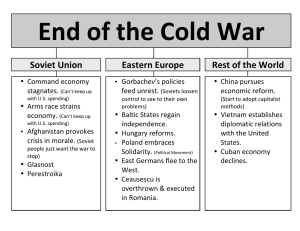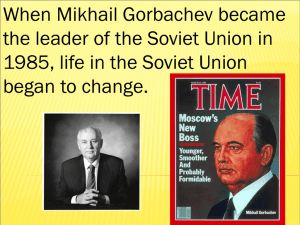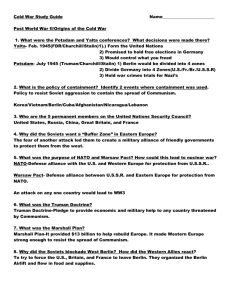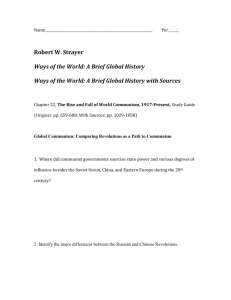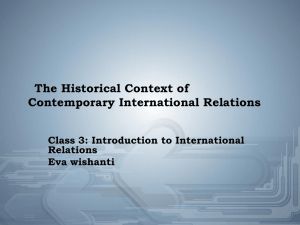Economic Development and Transition
advertisement
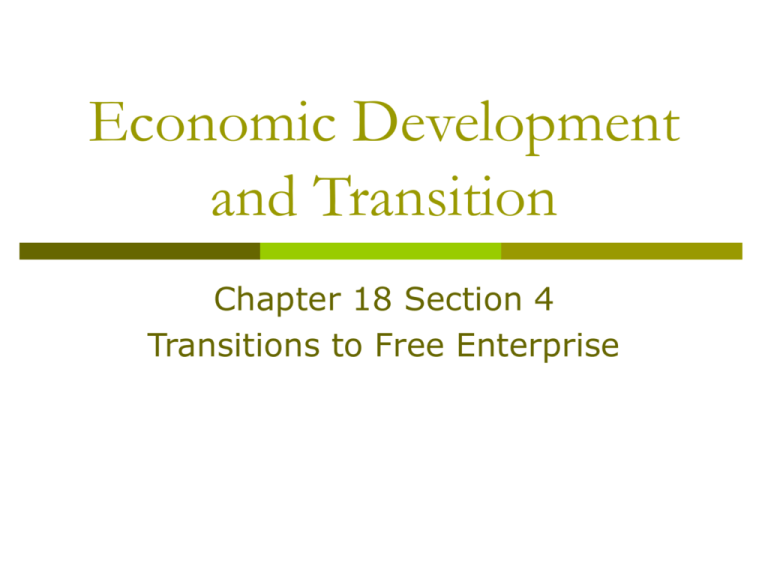
Economic Development and Transition Chapter 18 Section 4 Transitions to Free Enterprise Economic Development and Transition Objectives: * Identify some important steps in moving from a centrally planned economy towards a free market economy. * Describe the political and economic changes that have taken place in Russia in recent decades. * Describe the actions that China’s communist government has taken to introduce free market reforms into China. Economic Development and Transition Section Focus: Making the transition from a command economy to a market economy is a difficult process. The shift requires tremendous changes on the part of the government and the workers. Economic Development and Transition Most LDCs have discovered that a centrally planned economy limits development. Many communist nations are reshaping their economies. Former Soviet Union, Cuba, North Korea, and etc. They have dismantled their economies and replacing them with market-based systems. China has modified their command economy to incorporate some free market practices. Economic Development and Transition The transition to free markets and capitalism is a huge adjustment for an economy and a nation. Economic Development and Transition Moving Toward a Market Economy: One of the key elements of a command economy is that the government, not individuals, owns and controls the factors of production. The government answers the three key economic questions. First step moving from a command economy to capitalism is privatization. Economic Development and Transition Moving Toward a Market Economy: Privatization – the sale or transfer of government-owned businesses to individuals. Private ownership give the individual, not the government, the right to make decisions about what to produce and how much to produce. Ways to do this… 1. sell the business to one owner 2. sell shares in the business to interested people 3. give every citizen a voucher or certificate that can be used to purchase shares in the businesses when they are privatized. Economic Development and Transition Protecting Property Rights: Even when the government gives up its role as the owner and decision-maker, they play a vital role in the economy. Their role is to ensure the success of a new market-based economy. Government must set up private property laws to protect people who own the land. Entrepreneurs need laws to prevent criminals from stealing their profits. It takes time to develop a legal system that will support a market-based economy. Economic Development and Transition More New Roles for Government: The Government must be prepared to deal with the unrest that might develop from rising unemployment. The government must also play a role in helping workers make the transition from a centrally planned economy to a market-based economy. Workers in transition often need to learn a new work ethic – system of values that gives central importance to work. In a free market economy, incentives, not quotas, influence people’s labor. Economic Development and Transition Transition in Russia: Soviet Union was once the most powerful communist nation. The lagging Soviet economy prompted economic and social reform. Change came quickly to Russia, as economic freedom led to the desire for political freedom. Economic Development and Transition Communism in Russia: Soviet Union arose out a revolution in 1917. Vladimir Lenin, took control of the government He had a repressive form of control The Soviets reorganized their farmland into state farms and collective farms. State farm workers received wages, similar to factory workers. They had few incentives to encourage people to work hard. Agricultural output was low. Economic Development and Transition Communism in Russia: Soviet policy emphasized the development of heavy industry. By 1940, the Soviets were the 2nd largest producer of iron and steel in Europe. With so much devoted to heavy industry, very little was left for consumer goods. The every day items were in short supply. Economic Development and Transition Glasnost and Perestroika: In the late 1980s, Mikhail Gorbachev began a series of radical political and economic reforms. He believed that economic prosperity could happen without political freedom, he introduced Glasnost – a policy of political “openness” that encouraged Soviet citizens to say what they wished for without fear of government persecution. Economic Development and Transition Glasnost and Perestroika: Gorbachev’s reform was a plan of economic restructuring called Perestroika. It called for a gradual change from a centrally planned system to a free enterprise system. Gorbachev’s main desire was to incorporate the use of markets and incentives into the existing structure of communism. Under this system, the government began to allow factory managers to decide what goods to produce and how much to charge for them. Economic Development and Transition Glasnost and Perestroika: They converted several factories used for military goods to the production of consumer goods. The transition was very difficult for the people. Economic reform produced some initial hardships. People lost secure government jobs, benefits, and pensions. Many people were hurt financially, especially the elderly. Economic Development and Transition Glasnost and Perestroika: Collapse of Communism – In 1991, the Russians voted in their first democratic elections. Gorbachev resigned as president at the end of 1991. The end of the Soviet Union as we knew it. Transition to the Free Market – Boris Yeltsin came to power and promoted a market-based economy. There were many improvements, but hardships continued. Economic Development and Transition Transition to the Free Market: In 1992, Yeltsin lifted all price controls Supply and Demand controlled the prices Money was moved to try and build up the urban centers. Corruption led to many problems. They received billions of dollars of aid from around the world. The World bank and IMF helped out the country. Things have got better for them, but they have a ways to go. Economic Development and Transition Transition in China: 1949 – Communist forces brought Mao Zedong to power. Promoted the Great Leap Forward intended to turn China into a world economic power in the shortest time possible. The government took over all of the land and the people were organized into self-sufficient settlements. These were communes of 25,000 people. Economic Development and Transition Transition in China: This Great Leap Forward was a huge disaster. The people had no incentives to work hard, so production fell. The country went through a period of famine and around 20 million people starved to death. Economic Development and Transition Cultural Revolution – - In the 1960s, Mao instituted this cultural revolution – intended so that China could further embrace communism. - Organized the Red Guard – young men and women to carry out his policy. They persecuted people who did not follow. He was trying to get rid of the “Four Olds” 1. old ideology 2. old thought 3. old habits 4. old customs Economic Development and Transition Transition to the Free Market: • • • Mao died in 1976. Deng Ziaoping took over He introduced a new approach that shifted power to local government. He introduced a program of economic reform He tried to incorporate some free markets into the economy. This program was called the “Four Modernizations” Economic Development and Transition Four Modernizations To improve agriculture, science and technology, and defense quickly. Agriculture – people had contracts with the government to produce so much grain at a certain price. Any amount of grain over that set quota, the farmer got to keep. Industry was to produce consumer goods so that more people would buy them and to produce more light industry (clothing, appliances, etc) Economic Development and Transition Economic Zones Deng set up four special economic zones along China’s east coast. Local governments in these zones were allowed to offer tax incentives to foreign investors. Businesses were allowed to make most of their own investment and production decisions. China began to have rapid economic growth (mainly along the economic zones). Today, China continues to grow economically. Economic Development and Transition REVIEW: 1. Identify three factors necessary for the transition to free enterprise. 2. Why is privatization necessary to create a free market? 3. What is glasnost? 4. What is perestroika? 5. Why was the Great Leap Forward such a disaster for China?
